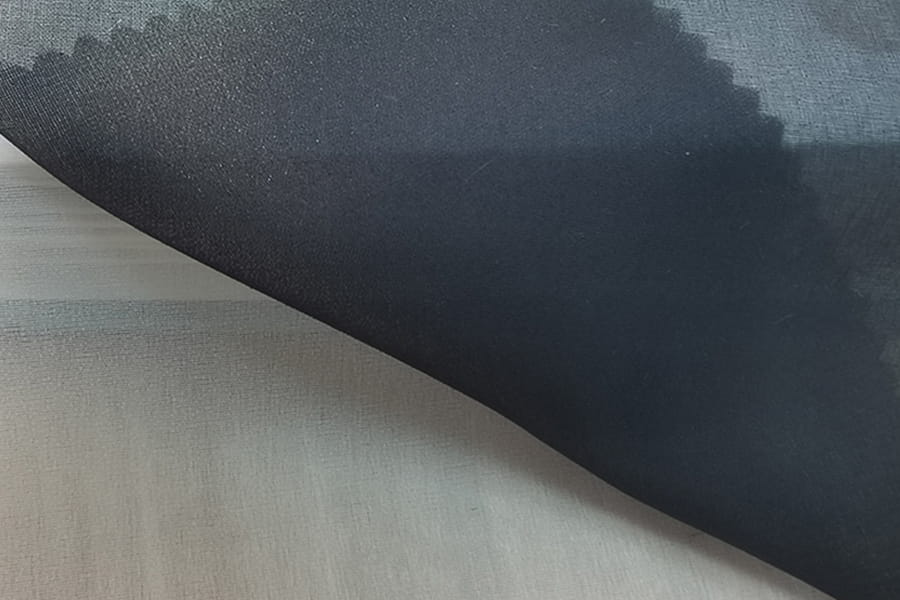To bond polyester fusible interlining effectively, controlling the temperature, pressure, and time during the bonding process is critical. These factors must be optimized based on the adhesive type, interlining structure (woven, nonwoven, or knitted), and the fabric to which the interlining is applied.
Temperature Requirements
General Range: Polyester fusible interlining typically requires temperatures between 110°C and 180°C (230°F to 356°F).Low-Melt Adhesives: Interlinings with low-melt adhesives bond at lower temperatures, typically between 110°C and 140°C. These are suitable for delicate fabrics prone to heat damage.High-Melt Adhesives: For heavy-duty applications or fabrics requiring more robust adhesion, higher bonding temperatures of 150°C to 180°C are often necessary.
Temperature Consistency: Uniform heat distribution is crucial across the bonding surface to prevent uneven adhesion, bubbling, or delamination.Fabric Sensitivity: Ensure that the temperature does not exceed the melting or distortion threshold of the outer fabric, particularly with synthetic or heat-sensitive materials. Using a press cloth or Teflon sheet can prevent scorching or glossing on delicate fabrics.
Pressure Requirements
Optimal Range: The bonding process generally requires pressure between 0.2 MPa and 0.5 MPa (2 to 5 kg/cm²).Light Fabrics: Apply lower pressure for lightweight or soft fabrics to avoid creating impressions or altering the fabric’s texture.
Heavy or Textured Fabrics: Higher pressure is necessary for thick or textured fabrics to ensure the adhesive penetrates into the fabric weave and creates a strong bond.Uniformity: The pressure must be evenly distributed across the entire surface to avoid weak spots, wrinkles, or air pockets in the bonded fabric.
Time Under Heat and Pressure
General Duration: The bonding process usually takes 10 to 20 seconds under controlled heat and pressure.Longer dwell times are beneficial for heavier fabrics or when using interlinings with high-melt adhesives.
Shorter dwell times are preferred for lightweight fabrics to minimize the risk of damage or distortion.Adjustability: The dwell time should be adjusted based on fabric thickness, adhesive type, and the nature of the garment’s application.
Pre-Bonding Preparation
Fabric Preparation: Ensure the fabric is clean, dry, and free of dust or finishes that might hinder adhesion. Pre-pressing the fabric can smooth wrinkles and stabilize it for bonding.Interlining Placement: Align the interlining carefully on the wrong side of the fabric to avoid misalignment or misplacement during the bonding process.Testing: Conduct a trial on a fabric sample to verify the settings and ensure the desired bond strength without fabric distortion.
Cooling and Post-Bonding Considerations
Cooling Under Pressure: Allow the bonded fabric to cool under slight pressure for at least 5-10 seconds to stabilize the adhesive. This helps set the bond and prevents bubbling or delamination.Inspection: Check for consistent bonding across the surface, ensuring there are no weak areas or signs of adhesive failure.
Variations Based on Fabric and Application
Stretch or Knit Fabrics: Use interlinings with some elasticity and avoid high pressure that may stretch or distort the fabric.Delicate Fabrics: Lower temperatures, lighter pressure, and shorter dwell times reduce the risk of damage.Heavy or Outerwear Fabrics: Higher temperatures and pressure, along with longer dwell times, ensure a strong bond suitable for structural support.
By tailoring temperature, pressure, and dwell time to the specific materials involved, polyester fusible interlining can bond effectively, creating a stable, durable finish that enhances the garment’s structure and appearance. Proper preparation, testing, and cooling are essential to achieving consistent results in both large-scale production and small-scale applications.

 English
English 中文简体
中文简体 русский
русский Español
Español









